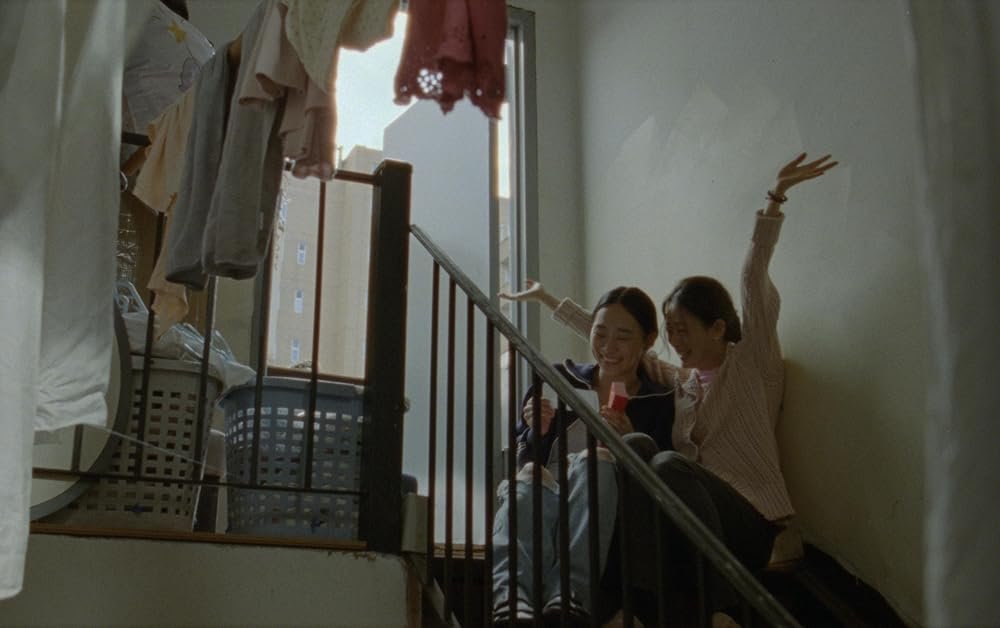
A disorienting film at first glance, Blue Sun Palace is the debut feature by Chinese-American filmmaker Constance Tsang. It takes place in the Chinese community of Queens, New York, and could easily be mistaken for a Chinese production if not for occasional English-speaking supporting characters. Blue Sun Palace is dominated by Mandarin dialogue, but it speaks in visual language that is distinctly East Asian. Loneliness, solidarity and longing to connect are the dominant themes of this deeply moving movie populated by wandering souls people whose lives have been uprooted without being transplanted elsewhere. This is a sad story with great actors like Lee Kang-sheng from Tsai Ming-liang’s films which herald an exciting new talent on American soil who can illuminate what it means to be alone among strangers who were once family members or neighbors when living thousands miles away from home.
Tony (Lee) and Didi (Haipeng Xu) are almost together: after dinner and karaoke one night he misses his bus so she lets him stay over at her place. She denies it next morning but roommate-coworker Amy (Wu Ke-Xi) still wants all details about that guy whom Didi sneaked into their room last night. Both women work at massage parlor where they meet different men every day; however Tony sees future in Baltimore city as well as restaurant industry for himself along with his talented friend who loves cooking too much not to become famous chef someday soon. But this dream will never come true because one evening after closing time some criminal attacks them violently making scared even more depressed than before.
Characters in Blue Sun Palace seem to exist between two worlds on one side there is their past which has been left behind forever while another world lies ahead full of unknown dangers as well as opportunities waiting for them somewhere out there. They all use American names already but everything around feels very Asian including Tsang’s visual style and set design. Karaoke songs are mostly performed by Faye Wong; also food plays significant role throughout narrative acting like bridge between present and memories or even emotions too strong to be expressed directly with words. However, connections from past times may seem fragile at best. Tony keeps having strained loveless video calls with his wife back in Taiwan whom he had to abandon due to huge gambling debts; everyone clings tightly onto old ways because new reality seems so cold-hearted unforgiving but once again there can be no return only forward moving forward always. They are left alone holding hands together before endless sea waves this is their sole chance for survival where one must rely upon another’s strength without any hope left to spare
Cinematographer Norm Li helps Tsang create this lingering sadness with her; the textures are grainy and the images moody, as if imitating dampened spirits and Wong Kar-wai or Tsai Ming-liang’s cinema. It’s already a nod to the Taiwanese master when Lee Kang-sheng is cast as a man who just wants some humanity; nobody can say “Funny how quickly the people you love become strangers” quite like him. But it also captures (without trying to be) some of Tsai’s melancholic downbeatness (think I Don’t Want To Sleep Alone or Days here). Compositionally it’s consistently strong, the mostly static camera only moving to emphasise the drama of the scene. The film even opens with a scene of Tony and Didi in a restaurant, their faces in close-up and the camera slowly panning back and forth; Tony tries to capture that feeling again with Amy later on, so does the film – but it doesn’t last, because Amy realises that Tony is just trying to fill a hole that her friend left in his heart.
It’s these kinds of touches that turn Blue Sun Palace into a mesmerising and devastating understated masterpiece when you realise it’s her debut, it starts to dawn on you that Tsang might be something special. She has clearly picked subject matter she knows well, but her cinematic language gives it a texture and emotional depth beyond the story itself. By showing how characters have to navigate this duality instead of looking at it through an American lens (like The Farewell or Past Lives do), this Columbia alumna’s film firmly stays on the ‘Asian’ side of things in terms of cultural divide within Asian-American experience (with Past Lives trying to meet halfway through Teo Yoo’s character, though – Nora faces duality too here). If for her next movie Tsang decides not to go with subtitles anymore so as to broaden her audience will she also change her sensibilities and what kind of a film will that be? This is genuinely exciting because Blue Sun Palace puts Constance Tsang on the list of young directors to watch closely in future.
For More Movies Visit Putlocker.